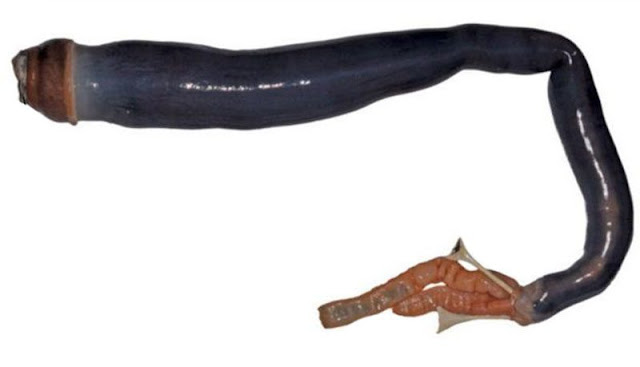The giant
shipworm (Kuphus polythalamia),
dubbed as the giant ‘tamilok’ in the Philippines, holds a lot of secrets. That is, until scientists saw a Philippine documentary on this giant ‘tamilok’ [1] on YouTube.
What we
know today is actually a result of a detour. A team of scientists led by Daniel
Distel of Boston’s Northeastern University were working with local scientists from the Philippines when a student of his prodded him to watch the said video. Distel knew they were on to
something big.
The creature is only known from fossils; it took centuries
to finally study in detail the first live specimens of the giant shipworm [1,2].
Echoing Margo Haygood, one of the authors, finding them is out of this world. It's like donning the role of an early, seminal naturalist where every seemingly trivial thing becomes an opportunity to bridge the unknown.
Fortunately,
that time is now.
The giant shipworm, as scientists had recently discovered,
is the only known member of the family Teridinidae (shipworms) that burrows in
marine sediments rather than drill in wood [1,2]. Unlike the wood-munching, notorious
ship-sinking shipworms [3], it is distinctly encased in a tube made of calcium
carbonate, vertically speared through the black, organic sediments in a shallow lagoon, wherein more than 75 to 80% of its body is buried [1].
Pulling one off from its murky bed reveals an adrift bleached staff… or is it?
Pulling one off from its murky bed reveals an adrift bleached staff… or is it?
 |
| The giant shipworm in its calcareous tube( Photo from Distel et al.) |
"Tok
tok tok..."
Distel,
the lead scientist of the study, is mystified. He didn’t know how to get the
shipworm out. Still, instinctively and carefully, he chiseled the chalky
head.
"... the shell came off, just like an egg.", Distel said [2].
Swiftly, here goes the flabby giant.
"... the shell came off, just like an egg.", Distel said [2].
Swiftly, here goes the flabby giant.
 |
| Photo from PNAS |
First impression: It's like a worm - a really big one. But it's actually a bivalve, a type of
clam. The modified pair of clam shells is positioned unto its head. The bulging
head houses the mouth as it tapers to a y-tail containing the two siphons. For
them to grow, they need to open the mouth’s cap, dissolve or reabsorb the cap,
grow and bury further, then seal it off again. These rare, enigmatic creatures
are the biggest (yet) among the existing bivalves today, reaching more than 5
feet [1].
Its
gunmetal black shade stunned the scientists. "Most bivalves are greyish,
tan, pink, brown, light beige colour. It is much beefier, more muscular than
any other bivalve I had ever seen.”, said Distel [2].
How Did It Get So Big?
Scientists
surmised that for the giant shipworm to grow so humongous, the key must lie on nutrient abundance.
But their anatomy is odd: The anterior end of its tube is covered with a calcareous cap which only periodically allows it to grow; when the cap is present, excavation and ingestion of sediments is impossible. Also, instead of a large wood-storing sac found in shipworms, theirs is a small, poorly developed digestive system (See Fig. 1). These characteristics could suggest that they don’t filter particulates, ingest sediments, or store wood [1].
 |
| Figure 1. Anatomy of the giant shipworm (Source: Distel et al.) |
So how exactly did they get
bigger?
In
essence, the giant shipworms are the descendants of their wood-feeding kin. That is, instead of munching their way through a wood with the aid of cellulolytic bacteria in their gills, the giant shipworms are left alone buried in the mud, while their sulfur-oxidizing chemoautotrophic bacteria do the job [1].
As wood degrades in the presence of bacteria, one of the wastes is hydrogen sulfide. It's a long chomping process. The giant shipworm's symbionts then re-oxidize the sulfide into sulfate, making available the organic carbon for its host [1]. In short, unlike the typical shipworm, it is readily provided with the fuel it needs.
Now, imagine the shipworm and its bacterial comrade for years end, perching in a slew of
rotting wood and organic deposits. Wouldn't a seafloor teeming
with hydrogen sulfide be the most fitting, generous, stench of a paradise?
That's their big story.
That's their big story.
To know
more about shipworms and the giants of the sea, visit SeaLifeBase. Our current information about this species is limited (and the online version has not been updated). If you have more information about this species, help us and be one of our collaborators.
_________
[1] Distel,
D.L., Altamia, M.A., Lin, Z., Shipway, J.R., Han, R., Forteza, I., Antemano,
R., Peñaflor Limbaco, M.G.J., Tebo, A.G., Dechavez, R., Albano, J., Rosenberg,
G., Concepcion, Schmidt, E.W., & Haygood, M.G. (2017). Discovery of
chemoautotrophic symbiosis in the giant shipworm Kuphus polythalamia (Bivalvia: Teredinidae) extends wooden-steps
theory. Proceedings of the
National Academy of Sciences, 201620470.
[2] BBC (2017, April 18). Live, long and black giant shipworm found in Philippines. BBC. Retrieved from http://bbc.in/2nXOeLm
[2] BBC (2017, April 18). Live, long and black giant shipworm found in Philippines. BBC. Retrieved from http://bbc.in/2nXOeLm
[3] Gilman,
S. (2017, April 25). The clam that sank a thousand ships. Hakai Magazine. Retrieved from

No comments:
Post a Comment
What do you think? Share your thoughts with us.